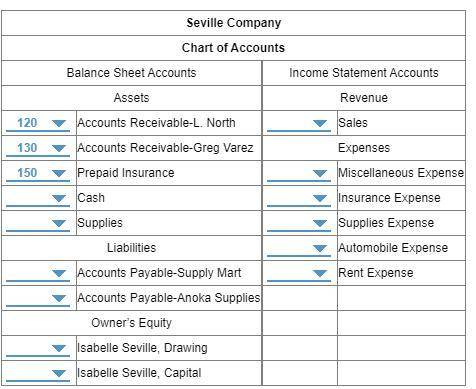
Now that each account has been classified, assign account numbers to each account. You must assign account numbers so that accounts receivable, accounts payable, and expense accounts are in alphabetical order (by last name, in the case of accounts receivable). Use 3-digit account numbers and number the accounts within a division by 10s.


Answers: 3


Another question on Business

Business, 21.06.2019 19:20
Chester has a credit score of 595 according to the following table his credit rating is considered to be which of these
Answers: 1

Business, 21.06.2019 21:00
Barbara jones opened barb’s book business on february 1, 2010. the company specilizes in editing accounting textbooks. you have been hired as manager. your duties include maintaining the company’s financial records. the following transactions occurred in february , the first month of operations. a. received shareholders' cash contributions on february 1 totaling $16,000 to form the corporation; issued 1,000 shares of common stock. b. paid $2,400 cash on february 2 for three months' rent for office space. tip: for convenience, simply record the full amount of the payment as an asset (prepaid rent). at the end of the month, this account will be adjusted to its proper balance. c. purchased and received supplies on february 3 for $300 cash. d. signed a promissory note on february 4, payable in two years; deposited $10,000 in the company's bank account. e. on february 5, paid cash to buy equipment for $2,500 and land for $7,500. f. placed an advertisement in the local paper on february 6 for $425 cash. g. recorded sales on february 7 totaling $1,800; $1,525 was in cash and the rest on accounts receivable. h. collected accounts receivable of $50 from customers on february 8. i. on february 9, repaired one of the computers for $120 cash. tip: most repairs involve costs that do not provide additional future economic benefits. j. incurred and paid employee wages on february 28 of $420.required: set up appropriate t-accounts for cash, accounts receivable, supplies, prepaid rent, equipment, furniture and fixtures, notes payable, contributed capital, service revenue, advertising expense, wages expense, and repair expense. all accounts begin with zero balances.tip: when preparing the t-accounts, you might find it useful to group them by type: assets, liabilities, stockholders’ equity, revenues, and expenses.2. record in t-accounts the effects of each transaction in february, referencing each transaction in the accounts with the transaction letter. show the unadjusted ending balances in the t-accounts. 3. prepare an unadjusted trial balance at the end of february.4. refer to the revenues and expenses shown on the unadjusted trial balance. based on this information, write a short memo offering your opinion on the results of operations during the first month of business.
Answers: 1

Business, 22.06.2019 23:30
Rate of return douglas keel, a financial analyst for orange industries, wishes to estimate the rate of return for two similar-risk investments, x and y. douglas's research indicates that the immediate past returns will serve as reasonable estimates of future returns. a year earlier, investment x had a market value of $27 comma 000; and investment y had a market value of $46 comma 000. during the year, investment x generated cash flow of $2 comma 025 and investment y generated cash flow of $ 6 comma 770. the current market values of investments x and y are $28 comma 582 and $46 comma 000, respectively. a. calculate the expected rate of return on investments x and y using the most recent year's data. b. assuming that the two investments are equally risky, which one should douglas recommend? why?
Answers: 1

Business, 23.06.2019 01:00
Jimmy's delicatessen sells large tins of tom tucker's toffee. the deli uses a periodic review system, checking inventory levels every 88 days, at which time an order is placed for more tins. order lead time is 22 days. daily demand is a constant 1515 tins, so average demand during the reorder period and order lead time (1010 days) is 150150 tins. draw a sawtooth diagram. assume that the beginning inventory level is equal to the restocking level and the desired service level is 99.9%. what is the safety stock level? (hint: look at the formula for calculating restocking level.) what is the average inventory level? the safety stock level is average inventory level is __chart: time (10,20,30), tins (0,150) lines touching both axisthe safety stock level is 0 tinsthe average inventory level is 75 tins
Answers: 2
You know the right answer?
Now that each account has been classified, assign account numbers to each account. You must assign a...
Questions

History, 26.06.2019 22:40















Computers and Technology, 26.06.2019 22:40






